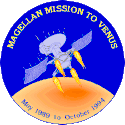
Back Magellanruimtetuig Afrikaans ماجلان (مسبار فضائي) Arabic Магелан (космически апарат) Bulgarian Magellan (svemirska letjelica) BS Magellan Catalan کەشتیی ئاسمانیی ماجێلان CKB Magellan (sonda) Czech Magellan (Raumsonde) German Μαγγελάνος (διαστημικό σκάφος) Greek Magallanes (misión espacial) Spanish
 Magellan with its Star 48B solid rocket motor undergoing final checks at the Kennedy Space Center | |
| Mission type | Venus orbiter |
|---|---|
| Operator | NASA / JPL |
| COSPAR ID | 1989-033B |
| SATCAT no. | 19969 |
| Website | www2 |
| Mission duration | 4 years, 5 months, 8 days, 13 hours, 18 minutes |
| Spacecraft properties | |
| Manufacturer | Martin Marietta Hughes Aircraft |
| Launch mass | 3,445 kilograms (7,595 lb)[1] |
| Dry mass | 1,035 kilograms (2,282 lb) |
| Power | about 1,030 watts |
| Start of mission | |
| Launch date | May 4, 1989, 18:47:00 UTC |
| Rocket | Space Shuttle Atlantis STS-30 / IUS |
| Launch site | Kennedy LC-39B |
| End of mission | |
| Disposal | Controlled entry into Venus |
| Decay date | October 13, 1994, 10:05:00 UTC |
| Orbital parameters | |
| Reference system | Cytherocentric |
| Semi-major axis | 10,470 kilometers (6,510 mi) |
| Eccentricity | 0.39177 |
| Pericytherion altitude | 295 kilometers (183 mi) |
| Apocytherion altitude | 7,762 kilometers (4,823 mi) |
| Inclination | 85.5° |
| Period | 3.26 hours |
| Venus orbiter | |
| Orbital insertion | August 10, 1990, 17:00:00 UTC |
 Legacy insignia for the Magellan mission, commemorating the deorbit of the spacecraft in 1994. | |
The Magellan spacecraft was a 1,035-kilogram (2,282 lb) robotic space probe launched by NASA of the United States, on May 4, 1989, to map the surface of Venus by using synthetic-aperture radar and to measure the planetary gravitational field.
The Magellan probe was the first interplanetary mission to be launched from the Space Shuttle, the first one to use the Inertial Upper Stage booster, and the first spacecraft to test aerobraking as a method for circularizing its orbit. Magellan was the fifth successful NASA mission to Venus, and it ended an eleven-year gap in U.S. interplanetary probe launches.
- ^ "Magellan". NASA's Solar System Exploration website. Retrieved November 30, 2022.
© MMXXIII Rich X Search. We shall prevail. All rights reserved. Rich X Search